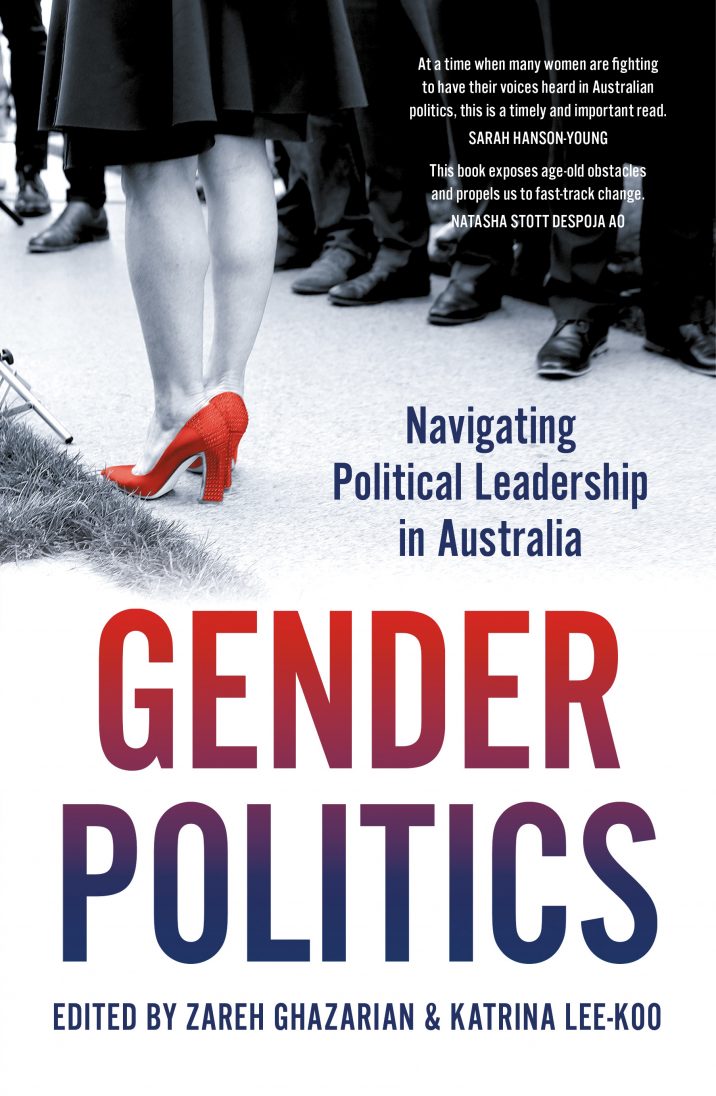Book Review: Gender Politics: Navigating Political Leadership in Australia

The hard-fought journey for women’s rights in the public arena is a continuous battle, with gender a site of political contestation and power struggle. Gender Politics: Navigating Political Leadership in Australia provides first-hand insight into Australian women’s experiences in politics.
Although women have conquered the right to participate in the political process, women’s political representation and everyday politics are still impacted by “boys club rules.” Historically male-dominated environments such as politics are still impregnated by a toxic masculinity culture, shaping the lived experiences of women in politics globally and in Australia. Gender Politics, edited by Zareh Ghazarian and Katrina Lee-Koo, shows how Australian political leaders predominantly embody masculinities that exclude the feminine, which are seen as “weak”, and any other lived experiences diverting from heteronormative paradigms. Ghazarian and Lee-Koo take a courageous perspective on gender in Australia’s political power play, breaking the silence on Australia’s political parties and politicians’ everyday practices in Parliament House.
Raising awareness is needed to increment a cultural change within Australia’s walls of power. Sharman Stone’s foreword asks, “why this, why now?” The present moment is pivotal for Australian political debate on gender issues, and how they negatively shapes women’s lived experiences. Grace Tame and Brittany Higgins’ speeches to the National Press Club earlier this year highlighted challenges faced by young women navigating Australia’s political sphere. Similarly, the book breaks the silence within the walls of Parliament House and Australian political parties, explaining how gendered political institutions impact women’s political careers, the way they are portrayed by the media, as well as their leadership opportunities.
Gender Politics brings to the fore of Australia’s political debate the gendered structures of power affecting the left and right sides of the political spectrum, raising awareness of the trials faced by women in Australian politics. The book sheds light on the national political culture centred on masculinity and stereotypical views towards women in politics, and how this dynamic impacts the women navigating Canberra’s circles of power. In Australia, views on masculinity and femininities are jeopardising women’s opportunities at the federal and national levels, compromising women and girls’ future contributions to the Australian political debate. Gender Politics brings into perspective the root causes of Australian politics’ gendered power play and endemic exclusionary political practices. The intimidation, bullying, and harassment of women in the workplace are still common praxis within Australia’s political institutions.
This edited volume is divided into four parts. The first part discusses gender and leaders in Australian politics, the second part maps out the gendered structures within political institutions, the third part explains gender in Australia’s political culture, and the fourth part dissects media representations of women and the role of masculinities in Australian politics. Each chapter reflects upon the ways gender shapes Australian governing institutions, from political participation to norms, behaviour, procedure, the language used by the media, as well as the impact it has on women’s opportunity to lead.
The highlights of Gender Politics are sections I, II, and IV on political leadership, institutions and structures, and media representation, respectively. Section I stands out by spilling out the bitter ordeal of women’s lived experiences within political parties in Australia. This section dissects masculinities employed by past leaders, suggesting that effective leadership in Australia embodies masculinity, excluding female leadership traits. Carol Johnson sees performative gender as a key driver in Australian politics and elections, “with forms of protective masculinity and images of the masculine provider playing particularly significant roles.” Hegemonic views of masculinity and power in Australian politics equally affect women from both sides of the political spectrum, having paved the way to Julia Gillard and Julie Bishop’s fate.
Paul Strangio, in “Shades of Grey” and Lee-Koo in “The unmaking of a feminist” write with elegance on the suffering endured by female political leaders within Australian political parties and the media. Julia Gillard endured media scrutiny and distasteful remarks about her civil status and wardrobe choices. Afterall, she dared to challenge the masculine status quo as Australia’s first prime minister. Why have no men in Australian leadership been criticised to the same degree for their physical appearance or wardrobe choices? How did Barnaby Joyce make a comeback as deputy prime minister, and why can men in politics seemingly get away with murder? Leadership focused on masculinity and political structures privileging masculinity pave the way for the differential treatment of men and women in politics based on their gender.
Section II discusses the perils of women in ministerial offices and political parties’ gendered politics of pre-selections. Section IV wraps up the book, climaxing in the last chapter, titled “They read about cars, and they read about footy,” which maps out political leadership, identity, and power in Australian elections. Author Stephanie Brookes explains that gender and politics is a “neglected area of study” and that “This is in itself a symptom of broadly gendered social structures with heterosexual, Christian, middle-aged, middle-class, white men’s operating as a norm against which all other identities are measured.” This chapter rounds out the difficulties of women navigating Australia’s corridors of power in an environment shaped by masculine roles, and ideals of leadership based on masculine traits and attributes.
In brief, Gender Politics is a key reading of our time, explaining the root causes of gendered politics in Australia. It sheds light on how a masculine culture still impregnates Canberra, creating barriers for non-masculine and feminine roles, and in particular female leadership to thrive. The toxic masculinity in Canberra and the gender dynamics within the walls of power impact not only women’s progress in public life but also political parties’ stereotypical views of women in leadership, fuelling public perceptions disseminated by the national media. All of this has a broader societal impact on Australia’s views on women in leadership, as well as in the imagination of prospective young female leaders. This gendered culture feeds women’s unconscious biases, fuelling impostor syndrome and intimidating women with the drive to lead. Unquestionably, this has an impact on the number of future women leaders in political parties’ pre-selection pipelines.
This is a courageous book, tackling the gendered nature of Australian politics both on the left and right sides of the political spectrum. Ghazarian and Lee-Koo don’t leave one stone unturned. Gender Politics raises fundamental issues in contemporary Australian politics that, if left unaddressed, will compromise women’s representation in national politics, and a fairer and more equitable Australian society for all.
This is a review of Zareh Ghazarian and Katrina Lee-Koo (eds.), Gender Politics: Navigating Political Leadership in Australia (Newsouth Books, 2021). ISBN: 9781742236933
Flavia Bellieni Zimmermann is a Lecturer at the University of Western Australia, Department of Politics, Society and Policy. She is a Brazilian political analyst and has written extensively in this field. Her research interests include Brazilian politics and society, Latin American politics, populism and nationalism, women in the global south, gender, politics and religion.
This article is published under a Creative Commons Licence and may be republished without attribution.





